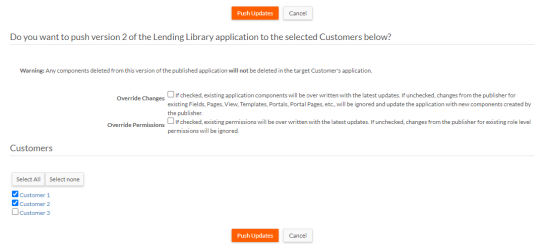Pushing application updates to other tenants
Publishers who have a hosted ISV account, or Private Cloud customers with sufficient permissions, can push application updates into any tenant where that particular application has already been installed.
Note:
- To minimize the impact on user sessions, try to choose a period of zero or low usage for pushing application updates.
- From Platform 6.5 onwards, pushing application updates to other tenants would be blocked if any duplicate labels or integration codes exist in the picklist items.
- You may still proceed with any of the above mentioned operation with duplicate integration codes. This is governed by shared property - SkipUniquePicklistCodesCheck. Tenant administrators can enable the same using the Skip unique codes check on picklist option from the Administrative Preferences section.
- If Object Type Attribute is enabled in the import Application, see Extending Object with Object Types.

Here's how it works:
- Publish your application to the Marketplace as version 1.
- Make sure your application is approved and available for installation (edit the Published Application record accordingly).
- Install this application into one or more target tenants.
- Publish updates to your application as needed. Each update will increment your app's version #.
- Once you are ready to push updates to all of your tenants who have this app installed, go to the Published Application view page for that app in the Master system and click Push Updates.
- On the next page, check Override Changes if you want changes in your application to override any customization made in target tenants (this option is always checked for fully managed applications). If unchecked, changes from the publisher for existing Fields, Pages, View, Templates, Portals, Portal Pages, etc., are ignored and the application is updated with new components created by the publisher.
- Check Override Permissions if you want permissions in your application to be updated in target tenants (this option is always checked for fully managed applications). If unchecked, changes from the publisher for existing role level permissions are ignored.
- Updates will be pushed into all target tenants who have lower version # of that application installed.
- Pushing updates will not override changes made by administrators on target tenants.
- If your application is fully locked, elements deleted from the original application (fields, triggers, etc.) will be automatically deleted from target tenants. If your application is not locked, no elements will be deleted in target tenants.
- Updates will be scheduled for installation in an asynchronous fashion. After an
update is completed in a particular tenant, that tenant will be reloaded in
memory and all users must establish new sessions (for this reason we recommend
scheduling a time to push updates during off hours for your users).
